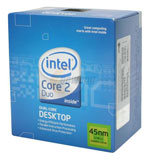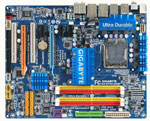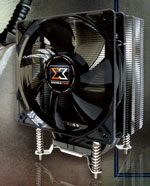Intel Value Midrange
While Intel still owns the very top in CPU performance, the Phenom II has made AMD competitive in the upper midrange to the low high-end. As higher speeds are introduced for Phenom II, that CPU parity will likely move up the CPU scale. That means that midrange to low high-end is now also an area where you can choose Intel or AMD based on the unique features of each platform or expansion capabilities, rather than one brand dominating performance.
The Intel Value Midrange is built around a fast Intel Core 2 Duo CPU. For most applications and gaming, a faster Core 2 Duo is normally a better performance choice than a slower quad-core. CPU intensive applications like video manipulation do benefit from a quad-core CPU, which should be your choice if those applications are important to you. A few recent games are finally taking advantage of quad-core as well.
| Intel Value Midrange PC | ||
| Hardware | Component | Price |
| Processor | Intel Core 2 Duo E8500 Wolfdale (3.16GHzx2, 6MB L2) |
$188 |
| Cooling | XIGMATEK HDT-S1283 120mm Rifle CPU Cooler | $37 |
| Video | SAPPHIRE 100259-1GB Radeon HD 4870 1GB | $230 |
| Motherboard | Gigabyte GA-EP45-UD3P | $137 |
| Memory | OCZ Reaper 4GB (2 x 2GB) DDR2-1066 Dual Channel Kit, | $46 |
| Hard Drive | Seagate Barracuda 7200.11 ST31000333AS 1TB | $110 |
| Optical Drive | LG BD/HD DVD / 16x DVD+/- RW GGC-H20LK | $99 |
| Audio | Creative Sound Blaster X-Fi Xtreme Audio 7.1 Channels 24-bit 96KHz PCI | $50 |
| Case | COOLER MASTER RC-690-KKN1-GP ATX Mid Tower | $80 |
| Power Supply | PC Power & Cooling S75CF 750W SLI CrossFire Ready 80 PLUS Certified | $80 |
| Display | Acer H213H bmid Black 21.5" 5ms HDMI Widescreen 16:9 Full HD 1080P LCD Monitor (1920x1080) | $199 |
| Speakers | Logitech X-540 70 watts 5.1 Speaker - Retail | $79 |
| Input | Microsoft CA9-00001 Black PS/2 Standard Keyboard and Optical USB/PS2 Mouse - OEM | $16 |
| Operating System | Microsoft Vista Home Premium OEM | $99 |
| Bottom Line | $1450 | |
 |
The CPU is one of the fastest Core 2 Duo chips on the market. The E8500 at 3.16GHz is just one step below the fastest Core 2 Duo E8600 which clocks at 3.33GHz. It also overclocks exceptionally well, reaching 4GHz and even higher with relative ease. Because of this OC ability and the value goal of this system build, the E8500 has been matched with components that are also excellent choices for overclocking. The E8500 is plenty fast on its own, but if overclocking interests you this Intel Value Midrange will be ready for action - and ready to overclock to wherever your particular E8500 can go.
 |
The big brother to the UD3R selected in our under $1000 guide is the $137 Gigabyte GA-EP45-UD3P that has a similar feature set but adds a second x16 slot (in place of a PCI slot) for dual x8 CrossFire operation. The board provides an excellent overclocking platform along with great stability. If the second x16 slot is not important to you, we suggest sticking with the UD3R. This P45 chipset motherboard has earned its reputation as a sterling overclocker, while also maintaining excellent stability. It is a good match to the selected Core 2 Duo E8500 or an alternate quad-core Q8200 (2.33GHz).
 |
While the stock Intel cooler is adequate for modestly overclocking a Core 2 Duo, better cooling is needed to push the CPU to its limits. The Xigmatek HDT-D1283 120mm Rifle Cooler did very well in our cooling tests and it is a good match to the E8500. OCZ also markets a similar 120 Rifle cooler and either should work well in this system.
For this Value Midrange system, faster memory with more overclocking headroom was chosen. With the current OCZ rebates some of their best memory is available at truly bargain prices. The choice for the Intel system is an OCZ Reaper 4GB DDR2-1066 (PC28500) kit. With attached heatspreaders and the unique Reaper heatpipes and external heatsink, this 4GB kit is ready for overclocking. The base specs of DDR2-1066 at 5-5-5-18 are also impressive even if you never overclock. Value is good at the normal $76, but with the current $30 rebate the price is an easy-on-the-budget $46.










77 Comments
View All Comments
Jorgisven - Monday, January 12, 2009 - link
I think one of the big qualms about calling this "mid-range" is that in general, the mid-range has been defined by the absence of the exponential cost/power ratio taking place. Right now, there is a substantial cost for only a fractional performance increase in these systems over something that costs half as much. Even with as much as the claimed "30 percent" performance increase, you're spending twice as much or more. You can build an amazing system, referencing the entry-level article, and the E7300 comes within 72% of the 965! Not the 920... however, the price of that system is 42% of even the 920. Granted, it's not just the processor that's different...With just an extra $50-100 on that entry-level upgrading to the E8600, you get within "88%"! So, in the end, we'll call it a 10% performance increase for a 200% price increase. (because that article references the 965, not this lower 920. I guessed on the 2% difference between the two).And a GTX280? Since when is that mid-range performance? It's pretty overkill for the 1920x1080 res of the monitor in my opinion (but it's just that). I'm of the opinion that you should not spend more on your graphics card than your display for a few reasons:
Displays are harder to upgrade, due to higher cost of shipping when trying to sell. Also, they technically aren't supposed to be thrown away (heavy metals) so they are more expensive to take care of if/when they break out of warranty. I would typically spend more on the monitor, and if needed, upgrade the card later, rather than the other way around.
strikeback03 - Monday, January 12, 2009 - link
Using the numbers published in Anand's release review of the Phenom II, here is the advantage the i7 920 holds over the E8600 and the E6750. The E7300 was not tested, and the E6750 generally performed better than the tested E7200, which is why I picked it to roughly represent E7300 numbers. All these are such that 100 means twice as fast or half the time to complete.920 over E8600: 50.6, 38.7, 72.4, 136.3, 44.8, 84.3, -6.8, 103.3, 148.6, 111.5, 43.2, 87.6, 64.2, 114.6, 59.3, -5.7, -3.4, 42, -2.7
920 over E6750: 97.1, 82.2, 118, 214.1, 89.7, 135.4, 24, 174.2, 216.7, 184.5, 100.4, 151.6, 122.2, 180.9, 94.2, 11.9, 19, 74.8, 2.9
Other than some current games and single-core Cinebench, the 920 is generally at least double the E6750 and 60% faster than the E8600. Replacing the processor, motherboard, memory, and power supply from the E7300 system guide with those from the 920 system guide gives a system price of $1268, so 52.2% higher for what is often more than 100% more performance in tested benchmarks. Obviously for lots of games or other single-threaded programs and internet, etc, the cheaper system is fine, but the 920 offers lots more performance for not a ton more money and on these programs does better than diminishing returns. Getting the price of an E8600 from Newegg today, switching that for the E7300 costs 983, making the $1268 920 system 30% more expensive for upwards of 60% better performance in CPU-intensive applications.
Wesley Fink - Monday, January 12, 2009 - link
As I stated on the first page it is my belief that a mid-range system, as defined in this article, should be “computing solutions with some staying power in the market”. I certainly don’t expect that of Entry or Bargain systems. That is the reason I stretched to select Mid-Range systems with Phenom II and an entry i7 Socket 1333 system at the top.As I said in the Guide, I had first put together a balanced Phenom 9950 system at the $1400 complete system price point. When Phenom II was introduced with an entry $235 920 part (just $55 more than the price of the 9950 on that day) and a top 790FX motherboard dropped its price to $105 it made more sense to pick Phenom II instead at that same $1400.
The Guide was ready to go last week with very different system selection. We did not have a Phenom II or an i7 in our recommendations then. However we knew Phenom II was coming Thursday, and we also knew it would shake up our System selections. That is why we reworked all the systems over the weekend and delayed posting until today.
Jorgisven - Monday, January 12, 2009 - link
Granted, by the time it gets around to upgrading a system using the Wolfdale or Yorkfield architecture, they will be hard pressed to find something better to upgrade to, as it seems that technology is getting dropped. I just feel this article is about 5-6 months early. I think the prices for these parts will be "mid-range" in about that time or so. So I guess this is a good planning article if you're not doing it this month or next...A well thought-out article, but I just disagree with the timing, a bit.
tester3000 - Monday, January 12, 2009 - link
That system is clearly not mid-range. Mid-range is around $800. That's a freaking high end and the $2000 is ultra-high end. Not many people can afford over $1000. $800 is the sweet spot for most people. Without monitor of course. Add another $200 for monitor.boboko - Tuesday, January 13, 2009 - link
>"That system is clearly not mid-range. Mid-range is around $800. That's a freaking high end and the $2000 is ultra-high end. Not many people can afford over $1000. $800 is the sweet spot for most people."Maybe. But the type of people who read Anand Tech and build a system from components will almost always keep about half the stuff from their old system. I'm getting ready to build a new PC, and all I'll buy is the CPU, MB, and memory. I'm still debating whether to buy a new video card, or wait a month or two for the prices to go down. But I'll keep my drives, my monitor, my case, my OS, my power supply, and my sound card and speakers, so even using these components that you claim are out of anyone's price range, I'll only be spending around $500, and I might make some of that back selling my old MB and CPU as a barebones that I stick into one of the several cases and PS's I got for free after rebate when Fry's was selling them evey month.
strikeback03 - Monday, January 12, 2009 - link
well, "most people" buy prebuilt from Dell or their local Best Buy, etc. For those building their own system, $1500 would generally qualify as midrange.The budget guide had a few builds under $1000 including monitor.
Jorgisven - Monday, January 12, 2009 - link
I'd agree. "Most people" will not be reading articles like this. "Most people who are looking at building their own" have a good idea of their budget, and it's generally higher than "most other people", because performance and control is more important generally speaking.elerick - Monday, January 12, 2009 - link
I have to agree with the author on this. He talked about the idea of reworking midrange, but ultimately stated his case for not changing.You can't please everyone, I build a new rig every 2 yeaars and I always do exactly what this author has put into an article. He choose the latest arcitectures and then picked the most affordable version / upgradeable. That is why the Core i7 920 ($300) and Phenom II ($235 & $275) were picked. I couldn't agree more with those picks for the month of January. Next month those picks could change, based on Intels counter pricing to Phenom II launch.
7Enigma - Monday, January 12, 2009 - link
From article:"Phenom II performance is more in line with Intel's latest Core i7, and for that reason we really wanted to select the Phenom II 920 for the AMD Value Midrange."
OK, the new Pheom II processors are definitely a good step in the right direction but this is a bit misleading to say IMO.